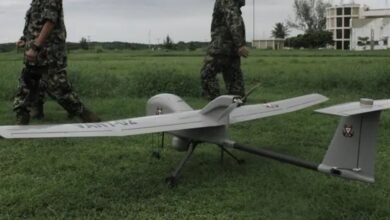“That’s not my dad”: uncertainty continues 34 years after the US invasion of Panama
Brigitte Bethancourt recounts the mystery of her father's disappearance during the 1989 U.S. invasion of Panama amid recent exhumations and DNA evidence that challenges official records and deepens the family's search for the truth.

12/20/2023.- Brigitte Bethancourt (r), 64, with her mother Iris Rosa Herrera show photographs of the North American invasion of Panama in 1989, on December 13, 2023, in Panama City (Panama). EFE/Welcome Velasco
EFE
Escucha este artículo
Leer en español: “Ese no es mi papá”: sigue la incertidumbre a 34 años de la invasión de EE.UU. a Panamá
The Pain of Invasion: A Personal Account
Four years ago the invasion of our hearts returned, we heard my father call on the phone a few hours before and tell me, 'The bicycle that I bought for my first grandson', who is my son, 'you put it on the tree in your mom' (…) we've been like this for four years, every time December 20th arrives."
With those words, Brigitte Bethancourt explains to EFE her feelings since the remains of a man who died during the United States invasion of Panama in 1989 were exhumed in 2019, who according to official records was her father, a fact that the family always denied. and that a DNA study confirmed months ago: indeed, it was not the Panamanian Braulio Bethancourt.
The Disappearance of Braulio Bethancourt: A 34-Year Mystery
34 years ago, Braulio Bethancourt was a 56-year-old officer of the now defunct Panama Defense Forces who was on duty at Fort Amador, located on the outskirts of the capital, as reported on February 1, 1990, by the newspaper La Prensa. -which is reported in an EFE cable from that date- by publishing a photograph of the "man missing since December 20" in a notice with which the family requested information about his whereabouts.
On the day of the invasion, Brigitte says, her father "had 14 people in his care" and when they "saw the American paratroopers" he decided that they should leave the place.
"But my father returns and tells them 'You follow me, I'm going to take instructions from Captain (Moisés) Cortizo,' who today is the brother of our president," Laurentino Cortizo, adds the 64-year-old woman. Since then his father's whereabouts have been unknown.
"That's not my dad."
With the reopening of 14 cases of missing persons during the invasion, remains were exhumed in 2019 in the capital's Jardín de Paz cemetery, where a tombstone bears the name Braulio Bethancourt.
The Family Complaint: Disagreement with the Identification of the Body
"The first thing they take out is my father's name and I tell my mother 'Don't worry, he's not my father,'" says Brigitte, a certainty that the family maintained since the mass exhumations carried out in April and May 1990, as This is explained by the December 20, 1989 Commission, an entity that has been working since 2016 on the identification of victims of the military intervention.
In 1990, the family reported that the physical characteristics and clothing of the exhumed body did not correspond to those of Braulio Bethancourt, as stated by the Commission in a statement last July, in which it explained that "one of the victim's daughters" had already He had recognized "a photograph of his father's corpse."
At that time, the family "was presented with a corpse of a man in his thirties, with complete teeth" and clothing in the fashion of that time, when the missing person "was 56 years old, had a gold tooth, and did not usually dress." in that way", since "he was a lieutenant of the Panama Defense Forces assigned to the General Command of the Defense and Security Commission (Cogecodese), whose offices were located in Amador," he added.
Despite the family's complaint, "my mother had to pay for the coffin, little by little" because "after an invasion, no one is financially well," says Brigitte while pointing to a photo of the coffin that remains hanging in the Commission 20 headquarters. from December.
On the tombstone that "was left with my father's name, this other person, who knows who is also looking for him," he adds and expresses his hope that his father's remains will be among those exhumed in 2019.
The December 20 Commission affirms that the exhumation reports indicate that the remains of Braulio Bethancourt could be found in another location within the common grave of the Jardín de Paz Cemetery or among the remains of 33 graves exhumed in 2019 in that place and that genetic analysis is pending.
Collective Pain: Families Without Answers
The Bethancourts "are not knowing where their family member is. That is part of the pain and tragedies that the invasion left behind. There are many families in that situation," Rolando Murgas, the president of the Commission that is working on the full identification of the victims, told EFE. The 439 dead or missing people are included in a registry that the entity has built and which is continuously updated.
This Wednesday marks the 34th anniversary of Operation Just Cause, which mobilized 26,000 soldiers and used state-of-the-art weapons to capture dictator Manuel Antonio Noriega (1934-2017) in Panama on drug trafficking charges, who had been a leader for decades. collaborator of the American Central Intelligence Agency (CIA).
Read also: Darien Jungle Becomes Global Migrant Highway Between Colombia and Panama
US documents declassified over the years and published for the first time in December 2019 indicate 516 deaths during the invasion, of them 314 soldiers, and the vast majority Panamanians, while unofficially there is talk in Panama of between 500 and 4,000 civilian deaths.




